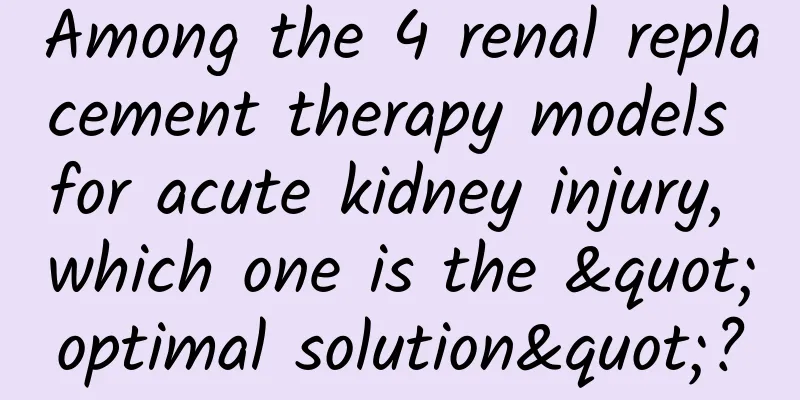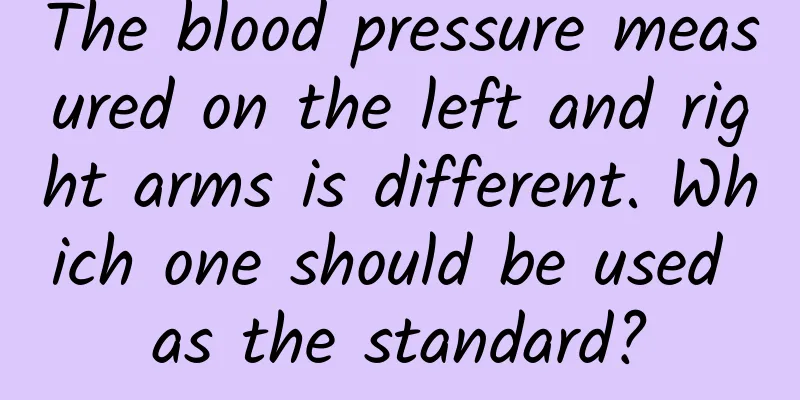Among the 4 renal replacement therapy models for acute kidney injury, which one is the "optimal solution"?

|
Generally, severe acute kidney injury (AKI) requires renal replacement therapy (RRT). Intermittent hemodialysis, peritoneal dialysis, continuous renal replacement therapy (CRRT) and extended intermittent renal replacement therapy are the four common modes of RRT. However, in clinical practice, physicians often worry about which RRT mode to use to treat AKI patients. Today, " Yilu Shenkang " will explain in detail the advantages and disadvantages of these four RRT treatment modes, and teach you how to make quick judgments and choices. Characteristics of 4 renal replacement therapy models When choosing RRT for AKI, the main purpose of treatment, the patient's metabolic disorder, the degree of volume overload, and whether hemodynamics are stable should be considered first, and then a comprehensive judgment and selection should be made based on the technical characteristics of RRT treatment. 1. Intermittent hemodialysis Intermittent hemodialysis is a traditional hemodialysis method and is also the most commonly used hemodialysis method for the treatment of AKI. The dialysis time is 3-5 hours each time, the blood flow is 200-300 ml/min, and the dialysate flow is 300-500 ml/min. Heparin, low molecular weight heparin or no anticoagulant can be used for anticoagulation. Advantages: (1) It can quickly correct water, electrolyte, acid-base imbalance and metabolic disorders of water-soluble low molecular weight substances; (2) The treatment time is short and has little impact on the patient's other treatments and examinations; (3) If necessary, anticoagulants do not need to be used to reduce the risk of bleeding; (4) The cost of treatment is relatively low. Disadvantages: (1) Hypotension may occur when fluid is removed rapidly; (2) There is a risk of dialysis imbalance and cerebral edema; (3) The technical requirements are numerous and complex; (4) Reverse osmosis water treatment equipment and dialysis machines are required, which cannot be implemented in places and environments with limited resources or poor medical conditions. 2. Peritoneal dialysis In recent years, with the continuous improvement and optimization of peritoneal dialysis technology, more and more clinical studies have shown that the use of peritoneal dialysis to treat AKI can achieve satisfactory results both in the ICU and in the ward [1]. Advantages: (1) Simple operation, no equipment requirements, and can be implemented in primary hospitals; (2) There is basically no demand for water and electricity, and it can be used even in extreme and special environments; (3) No need for extracorporeal circulation, and hemodynamics are not affected; (4) No systemic anticoagulation is required, and the risk of bleeding is not increased; (5) It is the most economical treatment mode. Disadvantages: (1) High requirements for peritoneal dialysis catheter placement technology; (2) Slow onset of effect, relatively low small molecule clearance rate, and slow fluid clearance rate; (3) May affect diaphragmatic movement and cause respiratory problems; (4) Protein loss may occur; (5) There is a risk of peritonitis; (6) Requires an intact abdominal cavity and is not suitable for patients undergoing abdominal surgery. 3.CRRT CRRT refers to a treatment model that uses 24 hours or nearly 24 hours of continuous extracorporeal blood purification therapy to replace damaged kidney function. Advantages: (1) Relatively stable hemodynamics; (2) Easy to control fluid balance; (3) Slow and continuous removal of toxins; (4) Can be combined with other organ support therapies at the same time; (5) No water treatment equipment required. Disadvantages: (1) Requires continuous anticoagulation, which results in a relatively high risk of bleeding; (2) Patients’ activities are restricted, which affects other examinations and treatments; (3) Expensive. 4. Prolonged intermittent renal replacement therapy Advantages: (1) Slow solute and fluid clearance, similar to the degree of hemodynamic stability of CRRT; (2) Can reduce the use of anticoagulants; (3) Patient treatment time is shortened, which is conducive to other treatments and related examinations. Disadvantages: (1) Toxin clearance is slow; (2) The treatment technique is relatively complex and requires dialysis nurses to operate and requires close electrolyte monitoring; (3) The antibiotic dose needs to be adjusted, which is particularly challenging in the treatment of patients with multidrug-resistant bacterial infections [2]. In case of AKI, 4 modes can be selected At present, there is still much clinical controversy about which RRT is the best mode for treating AKI. However, from the analysis of patient mortality outcomes, there is no significant difference between the four RRT modes. For example, if intermittent hemodialysis is used as the initial treatment for AKI patients in the ICU, renal recovery may be delayed [3]; compared with intermittent hemodialysis, CRRT as initial treatment has no benefit in terms of patient survival or renal recovery, and may even be associated with adverse outcomes in patients with lower disease severity [4]; peritoneal dialysis is associated with the shortest renal support time and ICU stay; prolonged intermittent renal replacement therapy is associated with the shortest hospital stay and days of mechanical ventilation; there is no difference between CRRT and intermittent hemodialysis in terms of hypotension or other treatment complications, but compared with peritoneal dialysis, the risk of hypotension and bleeding in the extracorporeal treatment mode is increased. The above series of evidence-based medicine have shown that the effects of these four RRT modes on patient outcomes are very small. Therefore, in clinical practice, no matter which mode is chosen, it is reasonable for critically ill patients [5]. Although these four models are reasonable choices in clinical practice, one important principle cannot be ignored, that is, the " principle of personalized medicine ." Focus of selection: Following the principles of personalized medicine When AKI patients choose RRT mode, they should follow the principle of personalized medicine. This is mainly because the demand for RRT in AKI patients changes dynamically. Ideally, it is best to have a variety of optional equipment with various performances. Through accurate monitoring, the entire process of RRT preparation, prescription, initiation, implementation, program adjustment and termination of treatment for AKI patients should be considered in all aspects of the patient's condition, and personalized treatment should be carried out. In this way, the treatment effect and patient prognosis will be better. In areas with uneven economic development, the following recommendations are made for the selection of RRT for AKI patients: (1) The application of PD technology in AKI patients should be actively promoted ; (2) In renal ICUs and hospitals that are unable to implement CRRT, simple water treatment equipment should be considered when building ICUs to facilitate the implementation of extended intermittent renal replacement therapy and intermittent hemodialysis; (3) In economically developed areas and large comprehensive and teaching hospitals , appropriate RRT should be implemented in accordance with guidelines . summary In fact, each RRT technology for treating AKI has its own advantages and disadvantages. Intermittent hemodialysis is the most effective in removing fluids and solutes, so it is the best technology for treating hyperkalemia, hypermetabolic states, and removing water-soluble toxic substances; CRRT is most suitable for patients with hemodynamic instability and high requirements for fluid balance; extended intermittent renal replacement therapy combines the advantages of intermittent hemodialysis and CRRT, and is a suitable technology for hemodynamically unstable patients who need examinations and physical therapy during the day; peritoneal dialysis is the easiest, safest and cheapest treatment technology among the four technologies, and its advantages are more prominent in extreme environments. Therefore, AKI patients should adopt the most ideal treatment plan for the specific treatment goals of individual patients in different disease states and corresponding environments, and make adaptive adjustments according to the dynamic changes of the disease to meet the needs of AKI patients at any time and achieve better treatment effects. |
Recommend
Kukaifeng Baocheng: OTT has a significant growth rate, and the advertising value will subvert traditional TV
Today, the "2017 China OTT Large Screen Mark...
The physical examination showed that the tumor markers were elevated. Do I have cancer? It is important to understand the physical examination form!
Every year during the physical examination season...
3 major trends in social media operations in 2019!
The times are constantly advancing and trends are...
How did the ancients observe the night sky? Ancient Observatory: Decoding the Starry Sky for 500 Years
Have you ever looked up at the starry sky and wan...
Xpeng: 4,224 units delivered in November 2020, a record high
On December 1, 2020, Xpeng Motors announced that ...
How to use mini programs online and offline?
For WeChat mini-programs, we have a better unders...
IEA: Global energy sector roadmap to net zero emissions by 2050 (210 pages)
According to the Roadmap, near-zero emissions wil...
Annual review | 3 key words for brand marketing in 2019
Introduction: Frequent collaborations, frequent h...
These 7 steps helped me reach 1 million users in 6 months
Achieve 100,000 users in 6 months I had just arri...
CCTV vs. Apple: How to define online privacy?
CCTV is fighting Apple again, but unlike the last ...
Operating systems other than iOS, Android, and WP?
[[138339]] Sources revealed that Samsung will use...
Analysis of the operation matrix of Kaochong Postgraduate Entrance Examination
Excellent case analysis Case name: [Kaochong Kaoy...
These 4 overnight dishes are too dangerous. It is best to throw them away if you can't finish them.
It is said that "thrift is a traditional vir...
Fishing skills, professional fishing video tutorials, fishing experts teach you how to master fishing skills, fishing video skills tutorials, practical fishing skills
Fishing skills, professional fishing video tutori...
The wild vegetable season is here again. Poetry and ancient prose will help you appreciate the history of wild vegetable consumption
Spring is the season for all things to grow, and ...









